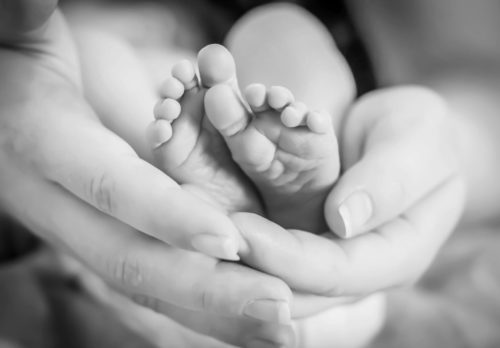Annette’s delivery date drew closer but, the excitement of meeting her daughter became overshadowed by fear. Annette had previously given birth to two large babies. Her eldest child had been born with mild shoulder dystocia, where one (or both) of a baby’s shoulders gets stuck inside the mother’s pelvis during labour and birth. She had been told that this was due to that baby weighing 9lb 3oz. Before this she had sadly lost twins at 32 weeks. The hospital were aware of the difficulties surrounding her pregnancies and delivery and had marked her records with a star.
As her pregnancy progressed she was told that it was more than likely that her daughter would weigh in excess of 10lbs. The size of her daughter was causing her a great deal of pain, discomfort and problems with mobility. She repeatedly made requests to have a caesarean section, which were refused on the basis that she had previously been able to deliver a large baby vaginally.
The size of her daughter was a major concern and she became frightened of the implications of giving birth to such a large baby. Every time she raised her concerns about the risk of shoulder dystocia happening again she was assured that there was no need to worry.
What went wrong during delivery?
During the birth, which proceeded vaginally, the head was delivered but the left shoulder became stuck, preventing the delivery of the body. The midwife began to pull on the baby’s head in an attempt to deliver the body. Annette remembers her using a great deal of force but to no avail; her daughter was stuck and her biggest fear had come true.
The midwife became flustered and called for assistance. Whilst waiting for help to arrive she continued to pull on the baby’s head in an attempt to deliver the body. Help arrived and they immediately began to reposition Annette and were able to deliver her daughter, who was by now blue and required resuscitation.
Annette was later advised that her daughter, Katie had suffered an Erb’s Palsy injury to her left shoulder. The midwife had not carried out the correct manoeuvre when she realised the baby was stuck, nor did she call an obstetrician for assistance. Instead, she negligently pulled on the baby’s head, stretching her neck and causing permanent nerve damage to her arm.
What happened as a result of the negligence?
As a result of the negligence at Nottingham University Hospitals Trust, Katie underwent three major surgeries as a child, following which she endured painful and lengthy periods of recovery. Despite treatment she has been left with a permanent disability and scarring. She required intensive physiotherapy from birth, which she will continue to need for the rest of her life.
During childhood Katie found her injury embarrassing and frustrating, her arm tended to hang limp and she could not do the same thing as the other children. As a result she was mocked and bullied at school. These days she just gets on with it and has developed little tricks to help her do things she finds difficult.
Katie’s current condition
Katie continues to be at a disadvantage in her everyday life. Amongst other things, she struggles to dress herself and use a knife and fork when eating. Hanging heavy washing out is impossible due to the restricted movement in her left arm. She is unable to carry anything heavy in her left hand and using a computer causes her pain and discomfort. She is also limited when it comes to employment and there are many jobs that Katie will never be able to consider.
Despite her injury Katie is extremely resilient and will find ways around her limitations. She now has a daughter of her own, however she struggles to hold her for any length of time and regularly relies on her partner and family to help care for her. Katie is likely to struggle more as her daughter gets older but her strong will and independence will ensure that she continues to find ways to adapt and overcome her problems.
Clinical Negligence Claim
Ison Harrison Solicitors were instructed to pursue a claim on Katie’s behalf. Evidence was obtained and the following failures were identified:
- There was a failure to consider and inform of the risks of shoulder dystocia;
- There was a failure to discuss alternative delivery options, including the possibility of a C- Section;
- There was a failure to involve an obstetrician;
- There was a failure to carry out appropriate manoeuvres once the baby was stuck;
- There was an inappropriate use of traction (pulling) on the head and neck causing nerve damage.
The Nottingham University Hospitals NHS Trust denied liability in full. Following further investigations and lengthy negotiations, Iain Oliver of Ison Harrison Solicitors was able to agree settlement in the sum of £350,000.
Katie is now able to make adaptions in her home and to purchase aids and equipment which will assist her to do the everyday tasks which she struggles with. She will also be able to access therapy and rehabilitation services, such as Counselling, physiotherapy and occupational therapy.
Although Katie has come to terms with her disability, she is likely to struggle for the rest of her life.
Do you wish to speak to someone in respect of a potential clinical negligence claim?
If you have concerns about the medical care that you or a loved one have received and want to have a chat to see if we can help you, please contact a member of the Clinical Negligence Team on 0113 284 5000 or alternatively email clinneg@isonharrison.co.uk.

















